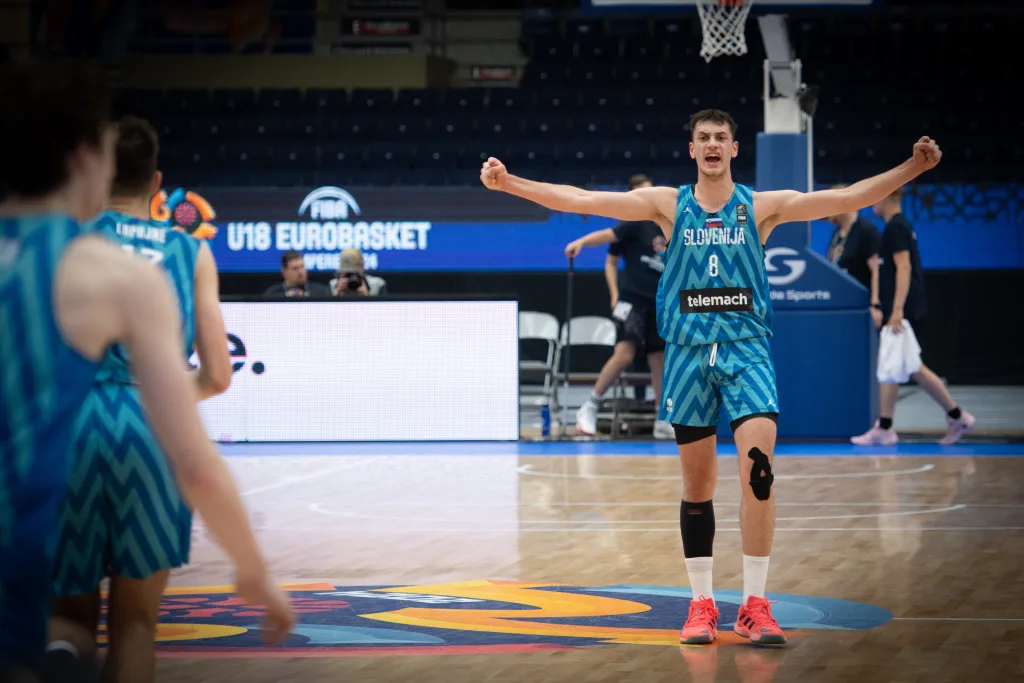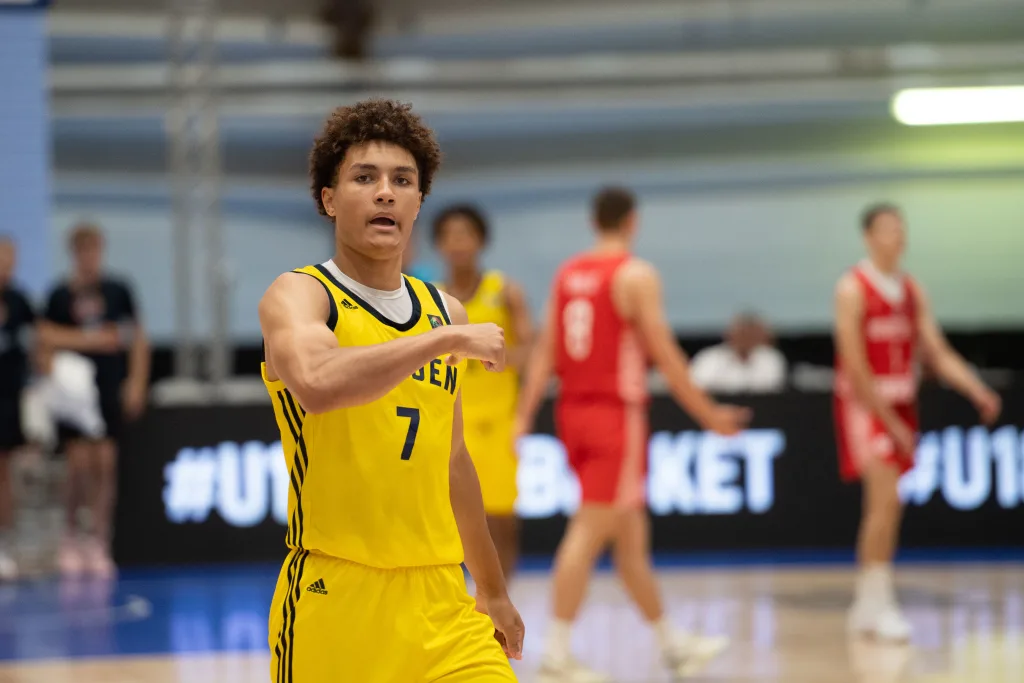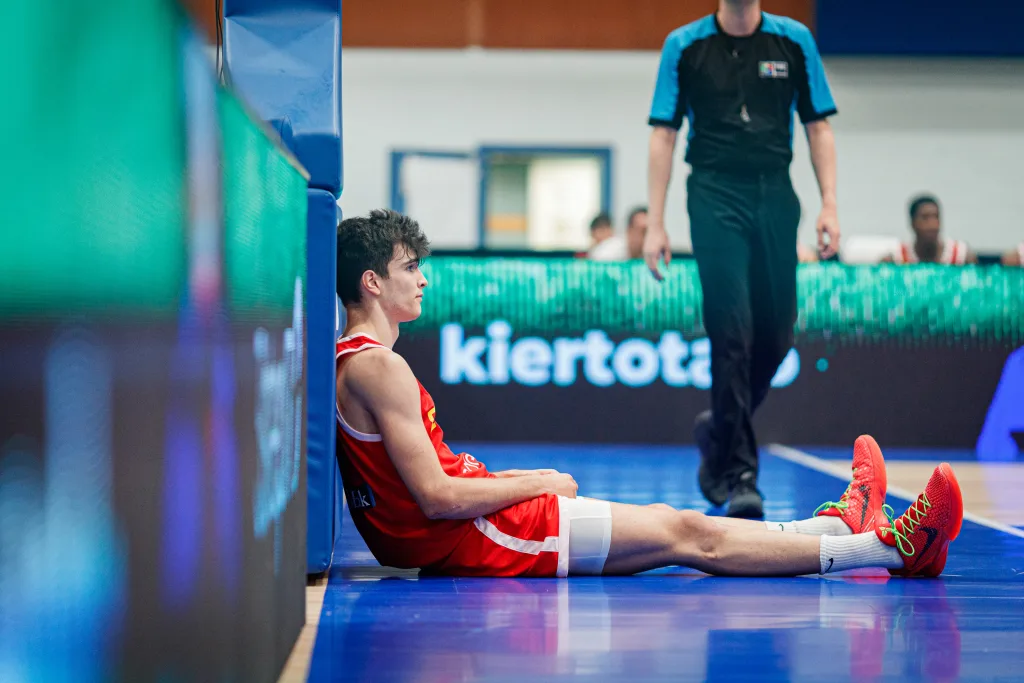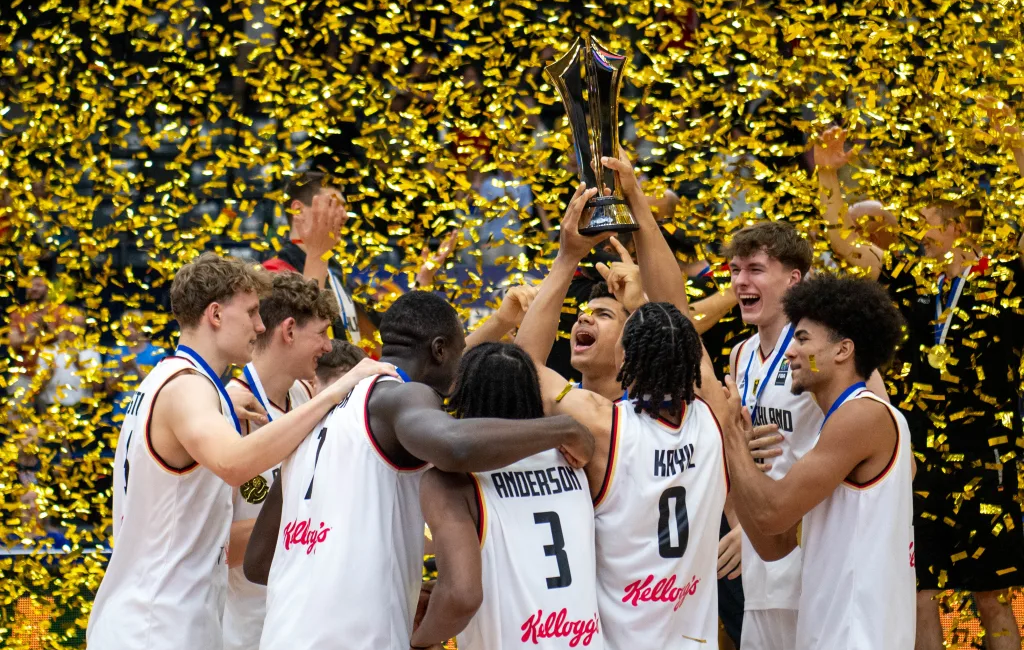Tampere hosted one of the most awaited U18 European Championships in recent history and the players delivered in superb fashion. An impressive pool of talented players went head-to-head in Finland, with Germany coming out on top in the end after defeating Serbia in the final. We followed the event closely and these are the prospects that stood out.
Germany
An impressive display from start to finish from a German team that went unbeaten in the seven games played. With a strong and cohesive starting lineup, all five of those players acted their roles as well as they could. Without a true “star”, Christian Anderson was the closest to reach that level. A 20.3 points per game scorer, the Texas Tech commit was a constant problem for opposing defenses with his paint attacks and shot creation. Jack Kayil continued to provide playmaking and shot the ball well from three as part of the dynamic backcourt with Anderson. Ivan Kharchenkov shined as a rim attacker, finishing 64.5% of his attempts from two, while Declan Duru’s size and mobility was a welcome sight on both ends for the champions. Despite the lack of size, Hannes Steinbach’s play finishing and rebounding prowess – averaged a double-double – was key in the middle of the paint for Germany.
Serbia
Serbia couldn’t repeat the success they had a year ago at home, but a 2nd-place finish consolidates them as one of the best teams in this age group. Georgia commit Savo Drezgic was the main man for Serbia with 20.4 points and 5.6 assists, controlling the team’s offense. Showed consistency in his shooting and rim attacks, while serving his teammates. Andrej Kostic was much more of a shooter than a driver due to Drezgic’s presence and his efficiency took a toll. He was still aggressive on offense and hit the game-winner in the semi-finals. 7-footer Aleksa Dimitrijevic was a huge presence inside for the runner-ups, finishing with 2.7 blocks. Despite not shooting the ball with his usual efficiency, his mobility and offensive versatility was important for his team. Milos Sojic and Mitar Bosnjakovic were the forwards for Serbia, exhibiting their two-way playstyle, something that was surely missed by Mitar missing the final. Milos was more of a rebounder and inside finisher, while Mitar tried to do a little bit of everything despite his shot not falling as it usually does.
Slovenia

With Slovenia’s only loss in the U18 EuroBasket coming at the hands of the eventual champions, one can say this was a highly positive outing for them. Without the power of a big name like some other teams, Slovenia went for teamwork but three players were clearly above the others. Urban Kroflic’s showing was nothing short of spectacular, finishing with 16.4 points, 8.6 rebounds and 5.4 assists. The 6’6 wing did a little bit of everything for his team, showing efficiency on all of his actions. Beside him, Zak Smrekar and Vit Hrabar were key for their national team. Smrekar provided a steady dose of scoring, especially inside, while Hrabar used his impressive 6’8 size on both ends, shooting well from three to add to that. The highly-touted Mark Morano (born 2007) didn’t see as much of the ball, but he was effective in his role, shooting 59% from two and 50% from three.
Israel
The two losses to close out the tournament don’t taint a highly productive showing for Israel, as they finished fourth in the U18 EuroBasket. No one even came close to the level of production Ben Saraf exhibited in Tampere, projecting him into one of the top spots in project lists after this tournament. The Ulm player was amazing scoring the ball and playmaking, finishing as the top scorer (28.1ppg, including two 40-point games) and 8th in assists (5.3apg). Scoring inside and out, it was impossible to stop Saraf en route to one of the best performances in U18 EuroBasket history. Right beside him, Omer Mayer didn’t disappoint as a ball handler. Scored, mainly inside, and found teammates at a high rate, compensating for a low efficiency shooting from the perimeter. His Maccabi teammate Yaron Goldman provided the opposite – some trouble finishing inside, but much better as an outside shooter, especially off the catch.
France
The last 2025 U19 World Cup spot was claimed by France, after beating Lithuania for 5th place. Propelled by the main table-setter in Nolan Traore, the French had an uneven participation but achieved the main goal. Traore finished with 9.3 assists on top of his 14.0 points, showing a willingness to pass and get teammates involved. He was still efficient inside and out, but his constant paint attacks got easy points for bigs and shooters alike. Noa Essengue showed out as an unstoppable force going to the rim, finishing at 67.2% from two. He was a constant threat as a driver and cutter, using his length to his advantage. Speaking of inside dominance, Joan Beringer shot 70.5% from two, finishing plays for his team while also being a shot deterrent at the other end. Mohamed Diakite proved once again he can be a versatile defender looking to create havoc on the defensive end while Leon Sifferlin shot the ball well as a secondary handler but also displaying some ability to initiate offense.
Lithuania
With eight players from the 2022 U16 team that won the European Championship, hopes were high for the Lithuanian team, who just couldn’t replicate their success, missing the 2025 World Cup berth on the last day as well. Still, Kasparas Jakucionis continued to show his floor general skills. The Illinois commit finished both as the 8th in scoring and assists, finding ways to the basket and keeping his teammates involved. While his shot didn’t fall, his relentless ball pressure on defense never wavered. By his side, Lithuania’s top scorer Nojus Indrusaitis, who’ll be playing at Iowa State next season, finished with 20.1 points, showing a consistent willingness to get in the paint, but als hitting above 35% of his perimeter shots. Mantas Juzenas wasn’t as productive in terms of efficiency, but still offered his team good perimeter offense, be it shooting or getting inside. Manning the middle, 6’9 Nedas Raupelis showcased his athleticism despite some trouble finishing plays around the basket. His explosive style of play was noticeable, especially defensively around the basket.
Belgium
It was definitely a summer to remember for a Belgium team that beat expectations to finish as the 7th best team in Europe. The dynamic duo of Jayden Hodge and Corentin Efono was especially in focus. The 2007-born Hodge displayed his ability to find any and every shot available, mainly from mid-range or at the rim. Efono, a 6’4 guard, showcased his driving prowess, finishing at nearly 60% from two, while staying above 40% from three on low volume. His distribution of the ball was exquisite as well, with 4.3 assists per game. Feie Tallir, another 6’4 guard, provided 5.3 assists, finishing as the eighth best in that category and helping Belgium with ball movement. Oskar Giltay was a huge presence inside at 6’10, finishing plays as a roller and cutter and blocking shots at the other end – 3.1 blocks per game, the best by a good margin at the U18 EuroBasket.
Sweden

Not many players took advantage of their opportunity quite like Julius Price, the second best scorer at the U18 EuroBasket. The 6’4 guard was impressive creating for himself and others all around the floor, finishing with 21.6 points on 56/44/70 splits and adding 5.1 assists. An electric and strong ball handler who’s always looking to make a play and rarely settling. One of the biggest winners of the tournament. 6’10 Samuel Obenjo continued his promising play from last season’s U18 Euro with another sensational run. Finished at nearly 70% from two, using his explosiveness and agility, while also being a top 6 rebounder. Casper Pohto got his imprint on this competition despite some efficiency struggles. Provided versatility offensively and a great dynamic pairing with Price. Setting them up, Nathaniel Nzonyansi didn’t shine as a scorer but as a table-setter. Was 6th in assists, looking to include everyone.
Italy
The Italians had a bit of an underwhelming tournament, never reaching the level that was probably expected of them. Still, their ninth place finish proved to be a solid spot. Dame Sarr was the face of the team and his performance aligns with the team’s display. Low efficiency on twos and threes and some difficulties translating his talent into on-court play. There were flashes of his electric scoring and playmaking, including a 24-point game to finish the tournament, but there was something missing. Diego Garavaglia continued to showcase his impressive defense, both on the perimeter or switching up to a big. On offense he opted to be more of a connector and sometimes a play finisher – his shot looked good, but on really low volume. Leonardo Valesin alternated between the good and some hidden games where he couldn’t get his shot to fall, but never let that take away from his on-ball creation and playmaking, finishing with 4 assists per game. 7’1, 2007-born Luigi Suigo continues to turn heads with flashes of rim finishing combined with floor stretching – shot 33.3% on 1.3 attempts per game. There is still a lot of work to do physically as well as his ability to make decisions faster, but Suigo is becoming one of the premier big men of his generation in Europe.
Greece
It wasn’t the finish Greece was hoping for, despite an interesting squad assembled for this event. Eleftherios Liotopoulos was the main man, shooting the ball often and with confidence, which saw him end at close to 40% from three. His inside finishing left a bit to be desired, but he compensated by getting everyone involved, finishing with 4.3 assists. Panagiotis Pagonis had a solid outing, providing efficient finishing inside and out, while having to play bigger than his size. His 50% from three on 3.4 attempts are a great indicator for him. Neoklis Avdalas didn’t quite live up to his talent in Tampere. He was looking for his shot, but forced some of them and never looked in rhythm. Even his passing, which is usually the most consistent part of his game, wasn’t there and the team suffered with it. He still finished with 11.4 points, third best for the Greeks. Andreas Patrikis took advantage of the opportunity, earning his minutes. Despite some inconsistent play, he was a good finisher inside and brought hustle everytime he was on the floor.
Türkiye, Latvia and Spain
A bit of a disappointment for Türkiye to finish in the bottom six, but a good sign having two 2007-born players in their top 3 in scoring (Kaan Onat and Derin Can Ustun). Onat was really good going inside and also finding teammates when the shot wasn’t there. For Ustun, he looked more comfortable shooting the ball than getting to the rim, while the playmaking and the defensive ball pressure were always there. Big man Salih Altuntas did a good job inside, finishing plays as a roller and grabbing rebounds, especially at the offensive end.
6’10 Kristers Skrinda had a great showing for Latvia, especially as a shooter. 43.9% on close to 6 attempts, while adding 10.4 rebounds, which guaranteed him averaging a double-double. 2007 Adrians Andzevs was a menace getting to the paint to either finish or find colleagues. 56.9% from two and 6 assists per game from him, while also being a defensive pest. Martins Kilups’ shot diet came from three most of the time, shooting 36.2% on 6.7 attempts. A quick shooting motion of the catch and someone to keep an eye on.

For Spain, it was a historical U18 presence – not for the best reasons – that almost culminated with relegation. But the play of Hugo Gonzalez and Mario Saint-Supery helped the Spanish team guarantee their presence in next season’s Division A. Hugo started slow but picked it up in the elimination phase, especially by getting to the basket and finishing well. The shot wasn’t there for him and the playmaking left a bit to be desired. Saint-Supery was more of an initiator, finishing with 6.3 assists (2nd total), to add to his 21.4 points. The efficiency wasn’t there for him, but having to play a role he’s not used to definitely took a toll on him. Playing more off the ball, Bruno Alocen was solid for Spain, shooting 37% from three on good volume. He was basically a floor spacer who ventured sometimes as a cutter, but most of his shots came from behind the arc.
Croatia, Finland and Denmark
Croatia caught the bad luck charm, having to fight with a desperate Spain team to stay in Division A and eventually getting relegated. 6’11 Ivan Juric was maybe the most consistent player for Croatia, finishing plays inside, getting out to the perimeter to shoot (50% on 2 attempts/game) and fighting for rebounds. A talented big man who improved his stock despite his team’s performance. Toni Torbarina was great shooting the ball, both at the rim and outside (57.1% from two and 50% from three, on close to equal volume). Despite proving to be a good distributor, he struggled a bit with turnovers as well.
Elmery Abbey had a bit of a slow start for the hosts, but finished well, with 15.3 points on 54.7% from two. His outside shot still isn’t there, but the electric driving and explosion were a sight to behold. Samu Adler was a bit of a do-it-all player for Finland and although his accuracy shooting the ball suffered with that, he was an important piece for his team with his versatility on both ends of the floor.
Denmark finished last in an uninspiring presence in Tampere. Still, 7’1 Marcus Moller stood out for the Danes, proving to be a great finisher inside (63.8%) and someone who can step out to the perimeter to shoot occasionally. His rebounding and rim protection, although not elite, were a welcome sight for Denmark. Frederik Erichsen finished third in assists, proving once again he’s one of the best passers in Europe at 6’9. His shot continues to be inconsistent and even his inside finishing wasn’t up to his standards, but his ball distribution continues to be at a high level.
























